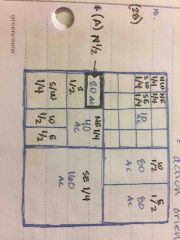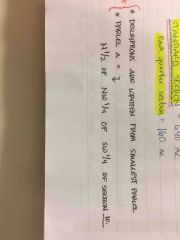![]()
![]()
![]()
Use LEFT and RIGHT arrow keys to navigate between flashcards;
Use UP and DOWN arrow keys to flip the card;
H to show hint;
A reads text to speech;
42 Cards in this Set
- Front
- Back
|
Standard parcel section size: |
640 acres |
|
|
A standard land section is broken into: |
Quarters (4) 160 acre parcels |
|

Front (Term) |

Back (Definition) |
|
|
Traversing: |
Survey technique that describes an area of land by series of connected lines, can be open or closed - open traverse= road - closed traverse = property boundary |
|
|
Township measures: |
Measures north and south of baseline |
|
|
Range measures: |
Measured east and west |
|
|
Section parcels are numbered in which direction? |
Right to left then left to right. Numbering starts in north east corner. A standard section is 1 mile square or 640 acres |
|
|
Plasticity: |
Is a soils ability to become deformed w/o breaking apart |
|
|
Elasticity: |
Soils ability to return to original shape after being subject to load |
|
|
A soils Liquid limit: |
Minimum water content @ which soil will flow under its own weight |
|
|
Permeability: |
Soils ability to transfer water |
|
|
Bearing capacity: |
Measure of a soil to decrease in volume under pressure of a given weight |
|
|
Fen: |
Wetland that receives nutrients from ground water and has non acidic peats |
|
|
A Meadow is: |
Periodically inundated wetland (may or may not have water present |
|
|
A quadrangle map shows: |
- topo for wetlands, stream & lakes - township, range & section - new construction since last survey |
|
|
Right of way, set backs and easements all restrict: |
Personnel use on private property |
|
|
Ada walkway w/o handrails max slope is: |
5% max. W/ 2% cross slope |
|
|
Wetland banking includes these 3 items: |
1. Consolidated creation of smaller wetlands 2. Transfers responsibility of creating wetland from developers to others 3. Provides incentives for others to restore wetlands |
|
|
Mangrove is: |
A wetland associated w/ saltwater |
|
|
Riparian forested wetland is: |
Associated w/ river or steam (home) |
|
|
Azimuth is: |
The position of the sun from east to west |
|
|
Soil moisture retention is affected by: |
Vegetation cover, particle size, slope |
|
|
Urban plazas use this to reduce reflected sun and heat: |
Light colored paving and vegetative ground cover |
|
|
Defensible space for wildfires should include: |
1. 100 ft in all directions 2. Maintain gravel paths, shrub beds, rock mulch adjacent to structure 3. Intermittent native woody plant 4. Tree limbs should not touch or hang over structure 5. Irregular arranged plants or discontinuous fuel supply |
|
|
Plaza space seating should include: |
1linear foot per 30 square feet of plaza space |
|
|
Farmland preservation plan includes: |
1. Land to be preserved as open space 2. Limit land development and construction |
|
|
Cul- de- sac benefits include: |
1. Allows more selective use of site 2. Presents difficulties from safety/ security standpoint 3. Increase in privacy |
|
|
Fundamental use diagram is: |
A bubble diagram, shows connections/ buffer between user |
|
|
Loam soil profile includes: |
40% sand 40% silt 20% clay |
|
|
Stadia measurement: |
Is a survey technique uses observed height of 6' tall object to infer Horizontal distance |
|
|
The (3) variables that conspire to start wildfires: |
1. Existing fuel load 2. Weather 3. Topography |
|
|
Community resource inventory includes: |
1. Wetlands 2. Archeological sites 3. Scenic views 4. Significant wildlife habitats 5. Historic structures 6. Forests 7. Floodplains 8. Farmland 9. Aquifers |
|
|
A chicane on a road is: |
An artificial narrowing or turn |
|
|
Angle of incidence is: |
The angle @ which a ray of light (usually the sun) hits a surface |
|
|
Topo survey contour info is considered accurate to: |
One half the contour interval (2' contours = accurate to 1') |
|
|
Slope and micro climates: |
- Western slopes= hottest in summer - southern slopes = most sun in winter - southeast slopes = most desirable microclimates - northwest slopes = cold winter winds |
|
|
Site attributes that vary seasonally include: |
-wildlife distribution - wind direction and speed - seasonal high water table |
|
|
Local zoning regulations may limit site development by: |
- restricting building heights - building site coverage - housing density |
|
|
(3) key elements that can be derived from a topo map: |
1. Elevation 2. Slope 3. Aspect |
|
|
Characteristics of Elevation: |
- variation in elevation produces slope that have both gradient and orientation - cool colors= low elevations - warm colors = high elevations |
|
|
Characteristics of Elevation: |
- variation in elevation produces slope that have both gradient and orientation - cool colors= low elevations - warm colors = high elevations |
|
|
Choropleth Map: |
A map that uses differences in shading, coloring or the placing of symbols within a predefined areas to indicate the average values of a property |

